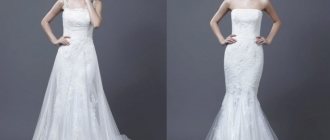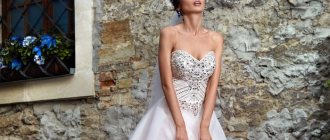In the vast majority of modern countries, it is customary to dress up in a white dress for a wedding. Before going down the aisle with her betrothed, every bride spends a long time choosing this very white dress - wedding salons are ready to provide a lot of solutions in different styles. Even more than that: there is wedding fashion, the current styles change every year.
Why is this so, where did this tradition come from? Why should a dress be white, while other colors are viewed very skeptically? Surely inquisitive people have asked this question at least once.
White color is not an axiom
Fashionable wedding dress
Today, this tradition is often abandoned - wedding dresses are chosen in multi-colored, beige, and blue shades.
Progressive brides are not afraid of judgment, remain aloof from prejudice, and can even choose a silver or black outfit. Sometimes it really is beautiful, looks unusual and interesting. Moreover, white color is not universal for all occasions and every nationality. Even today, many people prefer to choose other solutions without thinking about the generally accepted trends. Interesting fact: it is not customary for a number of peoples to use a white dress for a marriage ceremony.
In India, brides wear red, and in Japan, the girl wears two outfits at once, white and red. And many African and Asian peoples prefer to choose national costumes for weddings. In addition, the tradition of wearing white strengthened only in the 19th century, and originated 1-2 centuries earlier. This is a relatively recent trend, its occurrence is usually associated with one of the two cases when European queens began to choose this color for their wedding dresses.
Interesting: Why don’t they fasten the bottom button of the jacket? Reasons, photos and videos
A classic of the genre, or a traditional white dress for a wedding
Classic white dress for a wedding
So, wedding! Nowadays, a white dress and a wedding are simply inseparable concepts. As soon as we talk about the wedding ceremony, the image of an ethereal beauty in snow-white clothes .
Classic models of wedding dresses are currently considered one of the most popular. This is a universal combination of a tight corset and a luxurious full skirt. It is in this outfit that girls feel like fairy-tale princesses.
Traditional white dress for a wedding
The classic dress model looks like this:
- The lower part of the skirt is equipped with hoops , thanks to which volume is created.
- The fabric used for the dress is dense , which can fall in large folds.
- The skirt has several petticoats made of lining fabric or starched tulle.
Classic white wedding dress with a train
Classic options also include traditional wedding dresses, which have the following distinctive features:
- A-silhouette, where the skirt widens from the waist and falls in tails to the floor.
- The waist for this style is strictly defined, usually emphasized by a wide yoke or belt.
- This option can be decorated with a long train that is attached to the waist (it can be unfastened if necessary). A loop is sewn to the very tip of the train, which the girl puts on her wrist while dancing or moving along the street.
- A tight corset follows all the rules; it has a rigid frame and is laced or fastened at the back.
- The top of the dress can be either open or closed, depending on the wishes of the bride herself.
- The same goes for the sleeves. They can be long, short, 3⁄4 or completely absent.
White dress of the bride
The bride chooses shoes to match her white wedding dress depending on her own preferences. It can be:
- Traditional white shoes , ankle boots or boots with any shape of heel or no heel at all.
- Shoes can be classic style without decorations or decorated with rhinestones, beads and other accessories .
- The color of the shoes is matched to the belt, the bride’s bouquet, or traditionally white.
Traditional white wedding dress
Queens and wedding dress
Crowned lady in a wedding dress
Anne of Austria is a Spanish princess who chose a white dress for her wedding with the King of France. The marriage took place in 1615. Her image impressed those around her so much that later all wealthy ladies began to imitate her, choosing this color for their wedding dress. And then this fashion began to actively spread, the princess began to be imitated in other European countries, and then in Russia. Gradually this tradition passed from the upper strata of society to everyone else.
There is a second option, another answer to this riddle. In the second case, the fashion for white wedding dresses is attributed to Queen Victoria, who ruled England - she married Albert of Saxe-Coburg and Gotha in 1840. The woman thought that the traditional look with silver brocade would not suit her, and opted for a white dress, which was very new. After all, silver color was traditional at the weddings of the ruling persons of this country. She put on a white satin dress, each sleeve of which took up to half a meter of material just for decoration. This material was hand-woven lace, which was prepared for six months by a whole village of craftswomen, and after the wedding the outfit was destroyed so that no one would try to copy it.
Wedding dress options
Let the white dress not seem to you an exclusively classic or even boring option, because there are many styles and variations. Let's look at the most popular ones.
Lush white wedding dress
The dream of most girls is a luxurious and lush white wedding dress, as in the photo:
Lush white wedding dress
This model has a wide skirt and corset. The main features of the outfit are as follows:
- The width and volume of the skirt directly depends on the number of hoops or petticoats. Very often this design has quite a serious weight, but this fact has never stopped any girl if she decided to look like a queen at her own wedding.
- As a rule, these models have a strict corset with a minimum of decoration . The whole emphasis is on the skirt.
A delightful, airy and openwork lace white wedding dress has recently become the most popular among brides
It will look sophisticated and elegant at any celebration. Openwork fabric creates a magical, airy image.
Openwork lace white wedding dress
When choosing this option, it is worth considering some nuances:
- If you decorate a white lace dress with a train made of the same fabric, it will look elegant and expensive.
- Shimmering openwork fabric decorated with small rhinestones, pearls or sparkles will look royally magnificent.
- In itself, a wedding dress made of this material is absolutely self-sufficient, so you should not overload it with additional accessories.
Openwork wedding dress
Short white wedding dress
Young ladies with beautiful slender legs prefer short wedding dresses. It should be noted that traditions do not prohibit wearing a shortened outfit to a wedding , only on the condition that the bride herself likes this image.
Short white wedding dress
Models that have some characteristic features look impressive:
- Typically, a short white wedding dress resembles a classic cocktail dress .
- To ensure the correct placement of accents, designers use only luxurious fabric in creating models.
- In such versions of dresses, a very tight corset is usually not used .
- Sleeves can be of different lengths: long, T-shirt, lanterns, 3⁄4, sleeveless at all.
- They look great when complemented with a stylish bolero, stole, or cape.
Short wedding dress
Designer white wedding dresses
Fashion does not stand still, and modern designers have come up with many options for stylish and amazingly beautiful white wedding dresses, which are rightfully considered exclusive.
The research of fashion designers has gone so far that it is sometimes possible to guess that this dress is intended specifically for a wedding celebration only by the white color and the veil that comes with the set.
White designer wedding dress
The most fashionable white wedding dresses have some features:
- Designers make the bottom of the models asymmetrical. For example, the hem of a dress is much longer in the back than in the front.
- Currently, white wedding dresses in retro style are coming into fashion , the style of the 20s of the last century is especially relevant.
- They can be decorated with various large accessories that are not traditionally used in standard wedding dress models.
Designer white bridesmaid dress
White wedding dresses with colored elements
The most daring and bright girls will prefer a white and red wedding dress. These are exactly the ladies who can afford to experiment with colors even at such a crucial moment. It is believed that the combination of white and red in a formal dress is an application for leadership in a couple .
White and red wedding dress
The white and red version of the wedding dress can have a number of details:
- Both the main details of the dress and the trim can be red: bodice design, belt, sewn elements .
- If the red background of the model is decorated with rhinestones, the shimmering effect will be simply stunning.
A white and black wedding dress looks especially solemn and elegant . Only a confident and self-sufficient girl can use the classic opposition of colors in a wedding dress. A wedding dress looks ideal if the skirt is made of heavy white satin and the bodice is decorated with openwork black lace. You can create a mysterious and mysterious image by placing white lace flowers along the hem of a white dress.
White and black wedding dress
Simple white dress for wedding
classic simplicity of attire has been and will be in fashion throughout the centuries . This is especially true for wedding dresses. A simple, sophisticated white wedding dress will look great on any body type. These models use a minimal amount of decor; the fabric used for sewing is expensive, but creates a feeling of light simplicity.
The most spectacular decoration of this model is the youth and beauty of the bride.
Exquisite white wedding dress
But this does not mean that even such young girls should not decorate themselves on this important day with jewelry as beautiful as themselves. The good thing about the white color of the dress is that you can match it with jewelry of any color. If you want to keep the white color scheme and a classic look, choose gold and diamonds or cubic zirconia.
Gold earrings with cubic zirconia, Kalina Zolotaya (price on the link)
Gold ring with diamonds, SL (price on the link)
Wedding dresses at different times
Slavic bride
It is believed that the first wedding dresses began to be used by the ancient Greeks - it was a white peplos, which was decorated with clasps on the shoulders. Brides were not supposed to wear jewelry; these clasps were the only accessories, and they tried to decorate them exquisitely. The richer the bride's family was, the more elaborate these decorations were. There were no fashionable dresses in Rome either - the girl was dressed in tight-fitting clothes, but she had more accessories, the bride had a lot of jewelry. In Rus', brides dressed up in accordance with pagan traditions. They were given a red sundress, which was believed to ward off evil forces with its color. Another option involved a smartly embroidered shirt and a red and blue checkered skirt.
Interesting: Why do all the swans in England belong to the Queen? Reasons, photos and videos
The skirt was considered a symbol of engagement - if a girl started wearing it, it meant that she had already been betrothed. Russian women sought to wear red things to weddings until the 18th century, only then the image of a snow-white dress gradually began to take root.
Bridal dress color
According to traditions that have been formed over several centuries, the color of the bride's wedding dress should be white, denoting the girl's innocence, purity and happiness. In addition, it promises the newlyweds a happy and long-lasting relationship filled with trust and mutual understanding. The white color of the wedding dress also symbolizes the blank slate from which the bride’s new life begins as a wife and keeper of the family hearth. But an increasing number of modern brides prefer other colors and shades of their wedding dress in order to stand out from the rest.
- The beige and cream color of the dress, despite its delicate shade, attracts frequent quarrels, which leads to adultery.
- The blue color of the outfit represents the sincerity and purity of family relationships. Therefore, the marriage promises to become unusually happy and strong, due to the fact that the spouses will be like an open book, namely, as open and honest as possible with each other. The best time to show off in a baby blue dress is a winter wedding.
- A green dress is a symbol of modesty, so family life will be modest, with financial problems, but you will be happy, unless, of course, your happiness is not in money.
- The golden color of the dress will bring a stable financial flow into the family life of the newlyweds, and also portends career success, as it is a symbol of good luck, prosperity and wealth. But in family relationships there may be a lack of understanding between spouses.
- Red wedding dress From time immemorial in Rus', girls got married in red, richly embroidered sundresses; it was believed that it protected the bride from damage and the negative influence of bad people. In addition, the color red is a symbol of the bride's maturity and wisdom.
- A brown dress for the bride will most likely not bring anything good to family life. Therefore, it can lead to a noisy divorce process with division of property.
- The orange color of the dress signifies the respect and complacency of others towards the married couple. Therefore, relatives and friends will listen to the newlyweds’ opinion on almost any matter.
- A pink dress is a symbol of tenderness, love and romantic feelings. It is believed that such a bride's outfit means a long and happy family life. But it is known that according to some signs, this color can bring financial difficulties to a married couple.
- Gray or silver - suggests a quick divorce. Therefore, if you choose this color, your marriage will be short, or will live without consent and mutual understanding.
- The bride's blue dress can lead to absolute indifference of one spouse to the desires and opinions of the other half.
- The bride’s purple wedding dress has different interpretations - on the one hand, a quick divorce; on the other hand, the emergence of strong, strong love and deep affection of spouses for each other, which is filled with special magic, because this color is a symbol of magic and enchantment.
- Black is considered a mourning color, foreshadowing many tears in an unhappy family life, possible widowhood. In addition, this is a symbol of repentance for what has been done, which may lead to the bride’s mental illness some time after the wedding.
Knowing what the color of a wedding dress means, you can now choose the right dress for yourself. However, you should not blindly believe in these signs, because in reality there were many cases that refuted them.
Medieval traditions
In Europe in the Middle Ages, there was no tradition of sewing a separate dress for a wedding - this was not done in the circles of common people. The girl simply chose the most beautiful dress she had and walked down the aisle in it. The dress might not be new, it could just be festive, she could wear it on special occasions both before and after the wedding. Only wealthy families, starting around the 15th century, began to give their daughters away in dresses specially purchased for this purpose.
Accordingly, medieval wedding dresses could be of any color; brides could opt for bright or dark colors; no one chose white. It is worth remembering that the dust and dirt on medieval streets did not contribute to the cleanliness and safety of clothing, and sewing a dress just for one occasion was a waste, even for wealthy families.
Wedding traditions in Russia
Wedding traditions in Russia can be divided into:
- pre-wedding traditions and customs (bride's viewing, matchmaking, betrothal, bachelorette party, groom's get-togethers or bachelor party)
- wedding traditions (bride ransom, wedding train, wedding, wedding celebration - also known as a wedding feast)
- after wedding traditions (second day, party)
There are a number of other wedding traditions associated with dresses, wedding rings, the bride’s bouquet, a garter on the leg, a wedding loaf, and so on. There are also modern wedding traditions that have appeared quite recently. Let's tell you more about them.
A modern take on wedding dresses
Gothic wedding dress
The snow-white dress of the bride, according to modern views, speaks of her purity and symbolizes innocence. In the past, such dresses were worn by “brides of Christ” - girls going to the monastery. And white also symbolizes perfection, a celebration of life. Thus, a white dress is by no means an ancient, but a very beautiful tradition, and whether to follow it is up to each bride to decide for herself. Many follow, because white dresses for brides today are offered in a variety of styles.
Interesting: Why is there a monarchy in England? Reasons, photos and videos
Weddings in wartime
Early 1940s Due to the Second World War, it became a period of sacrifice and shortages. Rationing of a number of goods was introduced, particularly silk, a popular material for wedding dresses, to those who could afford it.
While marriages were sometimes postponed or simplified as much as possible during the war, the ritual significance of the white wedding was on the rise.
Government propagandists portrayed the war as a fight for one's marriage and family, and manufacturers and sellers quickly found ways to profit from it.
Thus, the company that produces and sells home cleaning equipment Eureka convinced women that “you are fighting for your own small home and to meet your husband on the doorstep every evening.”
“The public rhetoric of the war,” writes Nancy Cott in Public Vows, “constantly emphasized the defense of democratic freedoms against Nazi aggression and Japanese imperialism, while emphasizing the personal and familial aspects of the American way of life.”
This trend aligned perfectly with the goals of the wedding industry. For years, Americans were led to believe that a proper wedding required a new and unique dress.
For example, one of the wedding consultant's manuals of the era stated the following: “The heirloom wedding dress, despite its history and perhaps sentimental value, does not guarantee you an unforgettable wedding day. "A dress like this can interfere with a bride's inalienable right to look her best on her day."
The Wedding Industry Association was even founded to campaign for the removal of restrictions on the use of silk in wedding dresses, arguing that it would boost morale. “American guys are fighting for our way of life, and this [wedding dress] is part of it too.”
By the mid-twentieth century, the wedding dress had become that sacred item of clothing that should be worn only once in a lifetime.
The story of how dentists made cotton candy popular
Why does a bride need long sleeves?
Under the sundress they wore a shirt, the sleeves of which were rarely embroidered. The shape of the sleeves could be different - narrow, fluffy, long (sometimes up to two meters) with slits for the arms. This unusual form appeared for a reason: it was considered a bad omen when the bride and groom touched each other’s hands during the wedding. Over the sundress, the bride could wear a soul warmer. Several petticoats were worn under the outfit - they gave the pomp that was so valued in a woman. Girls from boyar and princely families wore a long cloak of brocade with gold embroidery over their sundress. The dresses of rich brides were often embroidered with pearls and trimmed with fur. Some wedding dresses weighed up to 15 kilograms.
Peach wedding
In ancient Rome, peach color symbolized a large marriage. According to modern psychology, it is believed that peach color has a beneficial effect on mood and causes joy. Therefore, it is perfect for a romantic and touching wedding celebration, both in a classic and thematic style, the Svadebka.ws portal is sure
As you can see, all the shades described above have their own unique meanings. Which color should I choose? It all depends on what kind of atmosphere you want to create at your wedding celebration: if it’s mysterious and mystical, choose purple, harmonious - turquoise, delicate and dreamy - pink.
- 34 photos
What does a veil and other items of a bride’s wardrobe mean?
A prerequisite is that you cannot take someone else’s veil or gloves to your celebration.
In ancient times, a mother protected her daughter from envious and evil people with the help of a scarf on which various symbols were embroidered. It was customary to give such a talisman to a young girl before her marriage. Today this custom has almost been forgotten. Instead of a scarf, a hairpin is now increasingly used.
In England there is a tradition that at a wedding the bride must have something new, something foreign and something blue.
In addition to the outfit, you should choose the right shoes. Give preference to closed shoes, they will help maintain family well-being. Avoid clasps and laces. The presence of such accessories can contribute to poverty, and their absence will help ease childbirth.
Having learned folk signs about the bride’s wedding dress, you can safely get married without fear that some item of clothing can interfere with family happiness.
Features of preparing a wedding dress
It was very important to dress the bride correctly. Close people or best friends had to participate in the process. It was believed that a woman who had already been happily married for more than 7 years should help with dressing - then a good family life awaits the young wife.
It was believed that a woman who had already been happily married for more than 7 years should help with dressing - then a good family life awaits the young wife.
- According to popular belief, the bride’s outfit should include a borrowed item, except for a glove or veil. Previously, the mother gave her daughter a scarf with a talisman embroidered on it, which protected her from envy, the evil eye and other manifestations of negative energy. Nowadays, brides borrow some trinket from a relative or friend in whom they are really confident, for example, there may be one someone else's hairpin in your hairstyle.
- If you are not going to get married, then according to popular belief, you should not try on your wedding dress. After all, in this way you can scare off your future groom.
- When trying on, putting on a dress through your legs is strictly prohibited; it is recommended to first put it on over your head, then put your arms through the sleeves. This sequence of actions symbolized strong family relationships.
- Under the dress, wear one of the items of clothing that has a large number of knots, as protection from the evil eye. It was believed that a witch or sorcerer would cast a spell no sooner than he had counted or untied each knot.
- Neither before the wedding ceremony nor after, do not let anyone try on your dress or wedding accessories, otherwise expect frequent quarrels between spouses in the family.
- The bride should not iron or hem her wedding dress herself, just like her mother, due to unpleasant consequences. To do this, it is better not to iron it at all. It is recommended to give the item to the studio or entrust it to some distant relative.
- Adjusting an outfit after registering a marriage was considered a bad sign—a symbol of interference in the spouses’ family.
- According to popular belief, the bride should not look in the mirror in full wedding attire. Here you can use a little trick: if you want to see how you will look on your wedding day, wear all the elements of the festive look except one, for example, gloves or garters. Put it on immediately before leaving the house.
Of course, a wedding is a very touching and exciting day, so it is almost impossible to remember all the rituals and signs. It’s good to have a person nearby who honors traditions and will guide the bride at every stage. Especially if you don’t know the answer to the question - What to do with the dress after the wedding?
In fact, all signs are nothing more than many years of observations and possible coincidences. Moreover, happiness in marriage depends solely on the feelings and efforts of the spouses.
History of the wedding dress
A wedding is one of the happiest events in life, and often one of the brightest. Weddings were revered in all nations on a par with the birth of children. In each country, a wedding is subject to its own rules, traditions, according to faith and cultural customs. From century to century, many girls fantasize about what she will be like, what dress she will wear, what jewelry, shoes and other accessories that turn this day into a little fairy tale.
I want to tell you a little about the history of the wedding dress. And maybe this article will give you inspiration in creating your own works.
The wedding dress that is familiar to us has a long history and has retained many elements from the depths of centuries. For example, in many European countries there are still elements of dress from the pre-Christian era. Bridal veil - symbolizes the girl’s purity; The flowers that are given to newlyweds and used to decorate the girl’s outfit are also a piece of pre-Christian tradition. The prototype of the veil appears in Ancient Greece. Greek brides wore a white light floor-length dress with two clasps on the shoulders - “peplos”. The beauty and richness of the clasps spoke of the bride’s wealth. The head and hair were decorated with fresh flowers and a golden veil. The golden prototype of the veil represented the sun and happiness.
This style is one of the popular in Russia and Europe. I think each of us has seen it, and many have even tried it on themselves.
In Russia, the veil also has its own history. Initially in Rus' it was a painted scarf that complemented the beauty of a wedding dress. But it was not just a decoration; the scarf was supposed to protect the bride from evil spirits and the evil eye. With the advent of the Christian faith and over the course of time, the veil's color and material changed, its shape changed, but it still retains an important role in the wedding ceremony. A wedding veil has a sacred meaning; at first it symbolizes the bride’s innocence and still protects her from unkind glances. According to tradition, before the wedding or wedding, she covers the bride’s face, and after registration, already in the role of a wife, the veil is removed from her face or changed to a shorter one. At some weddings you can find a preserved ritual when, after registration, the mother-in-law lifts the veil or removes the veil from the girl, who has now become a wife. The veil must be kept at home, and after the birth of the child it serves as a cover for the cradle, protecting the baby from all harm.
But let's get back to the wedding dress itself. The tradition of the color of a wedding dress also comes to us from the past. However, the usual white color of the dress did not appear immediately. In Ancient Rus', wedding attire was red and decorated with various ornaments. The red color symbolized the beauty and fertility of a woman. In some regions, two bridesmaid outfits were used, the first was simple, sometimes even black was allowed, it symbolized modesty and sadness of leaving the family. And the second was “painted”, most often red or with an abundance of red ornaments. Symbolized the happiness and solemnity of the occasion. In those days it could not be called a dress; it was most often a light shirt with embroidery, with a red sundress worn over it. The shirt differed from the everyday shirt not only in the embroidery, but also in the long sleeves, sometimes their length reached 2 meters, since there was a belief that the bride and groom should not touch each other with their bare hands. Of course, the rich embroidery distinguished it from everyday attire. Initially, the bride had to decorate her wedding dress herself. But later this was done by professional embroiderers. The outfit most often used floral ornaments (flowers, leaves, berries), as well as birds. The bird was considered a symbol of happiness.
Preparing the bride for the wedding. V. Feklistov 1848.
A woman in a white dress was considered in Rus' to be the “bride of Christ” and meant that she was preparing to leave worldly life and enter a monastery. Later in Russia it will mean the purity and purity of the bride. Remarriage was never performed in a white dress.
Later, kokoshniks appeared in head decorations. In the 15th century, wedding dresses began to be made of brocade and embroidered with pearls. The weight of such an outfit could be 15 kg!
kokoshniks
Makovsky K.Ya. Hawthorn
And at the beginning of the 18th century, Peter the Great ordered all of Russia to follow European fashion. Traditional Russian wedding attire existed in villages until the 19th century, and in some places even until the 1917 revolution.
After 1917, weddings were canceled, and marriage registration began at registry offices. For the wedding, the newlyweds wore ordinary everyday clothes. Only in the 60s. Wedding fashion began to emerge again. Brides could buy simple models of wedding dresses or order tailoring of wedding dresses, but they were all about the same look: straight, with lace and ruffles, and a simple cut. After the USSR collapsed, wedding fashion salons quickly expanded their range, as beautiful wedding dresses began to be imported from abroad.
Actually, since the 18th century, Russian wedding fashion has practically kept pace with European ones. Russian empresses were married in rococo style dresses. The “Empire” style did not bypass Russia either. In the middle of the 19th century, French wedding dresses appeared in St. Petersburg and Moscow - with a huge amount of lace, on crinolines, with corsets embroidered with pearls, gold and silver.
Rich families even bought two outfits for the bride: one for the wedding ceremony - more formal, with a closed neck and arms, and the second - with a deep neckline and open shoulders - for a social celebration. This tradition dates back to ancient times and continues to this day.
But let's return to the color of the dress. The ancestor of the fashion for a white wedding dress was the French princess Murat, a charmer of the Napoleonic era. At the beginning of the 19th century, the fashion for antiquity led to the fact that white became the main color in wedding dresses. But only if they were getting married for the first time. During the second marriage, a woman (neither divorced nor widowed) had the right to a white robe. This fashion lasted for more than two centuries. In Russia, the fashion for a white dress was introduced by Catherine II.
Is it worth believing in signs and superstitions at all?
Dear brides! Only you can decide what to believe, how to choose a dress and prepare for your wedding day. But let's be honest - there is not a single statistical proof that this or that sign really works. Moreover, many signs and superstitions simply exclude each other.
But what you can definitely expect from signs is an extra headache. You have to pay attention to every little detail, which causes serious discomfort. And sometimes these are really things that you would never pay attention to just like that. Like the same number of buttons or trying on the entire wedding dress in front of the mirror.
The younger generation pays less and less attention to signs, but often does this only to please older relatives and guests, so as not to spoil their mood and themselves.
Our advice to you: find the sweetest and most suitable wedding signs for you and follow them. If you approach the issue carefully, it will only add to the atmosphere of your wedding day, making it even more unforgettable. When it comes to wedding dresses, always choose what you like. You are free! In addition, world-famous designers are not trying in vain, creating real works of art. And there is no point in denying yourself a chic wedding dress if it turns out to have an odd number of buttons.
And the last thing! Try to listen less to older people about all sorts of signs and superstitions. Keep in mind that talking about someone else’s happiness is, at the very least, cynical. Be yourself, love your chosen one and enjoy life. This is the most important sign!








